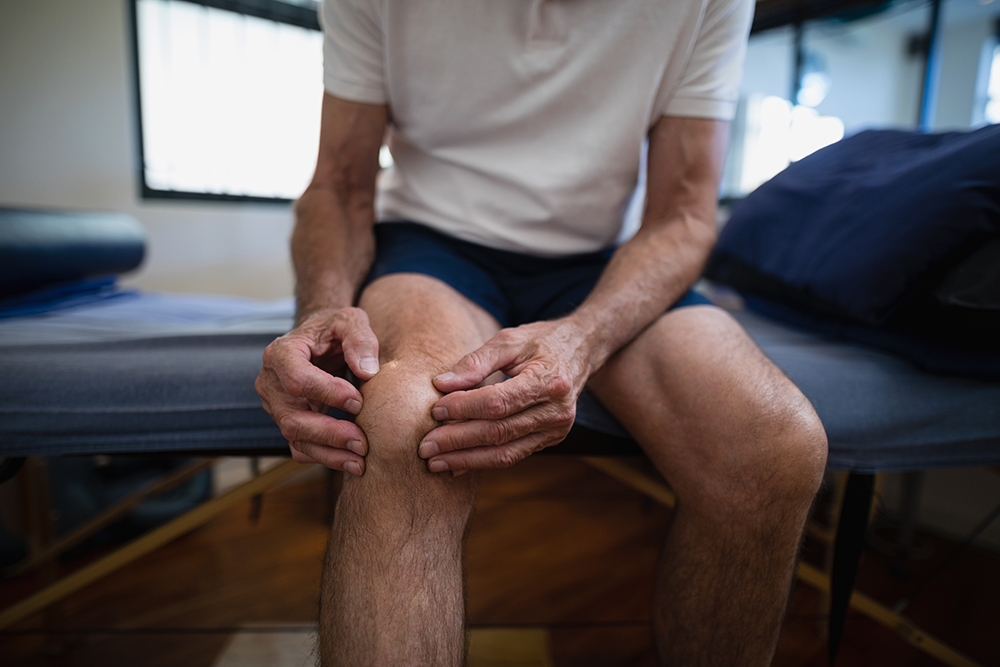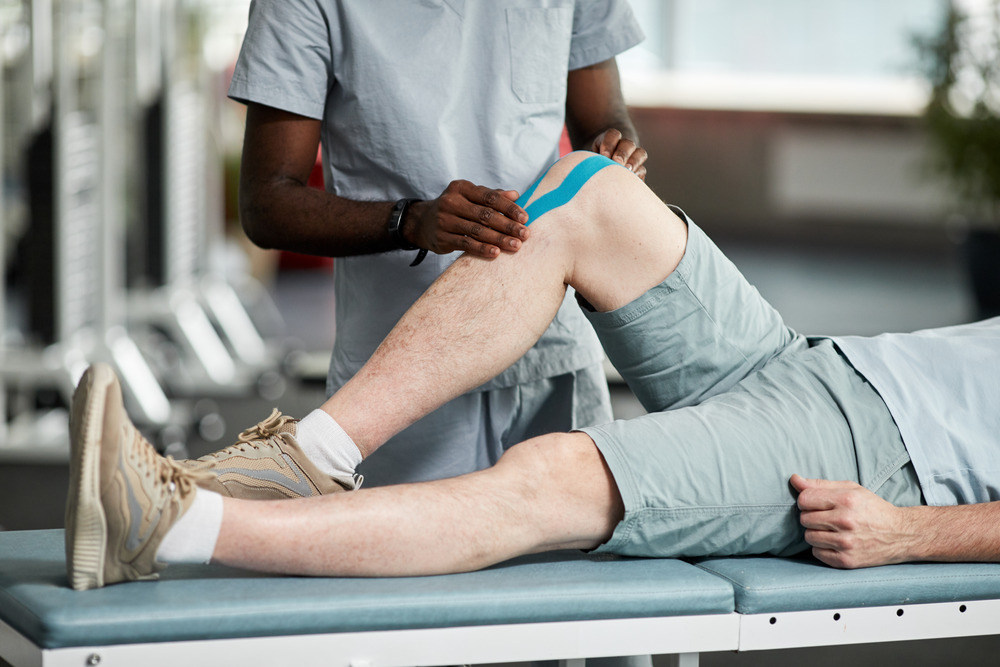Contents
The hip and knee joints are crucial for movement and stability. They are also two of the largest joints in your body. The hip joint is a ball-and-socket joint formed where the head of the femur, thighbone, meets the acetabulum, the socket in the pelvis. The knee is a hinge joint that connects the femur to the tibia, the shinbone. They make it possible for your body to support your weight and do a variety of activities, from walking and running to sitting and standing. Hip and knee pain can be a frustrating and limiting experience, affecting your daily activities and overall quality of life. Understanding the relationship between these two crucial joints and the possible causes of pain can help you find effective relief.
How are the hip and knee joints related?
The hip and knee joints are interconnected — an issue in one joint can affect the other. The joints work together to provide you with balance and mobility. Hip pain can lead to altered gait patterns, which in turn can strain the knee joint. Similarly, knee pain can cause compensatory movements, leading to hip pain.
Understanding the connection between these joints is crucial when assessing the pain and determining effective treatment options. Many people experience hip and knee pain on one side, which can be challenging, as it may indicate underlying issues that need to be addressed.
9 potential causes of hip and knee pain
There are numerous potential causes of hip and knee pain, including:
- Arthritis — Arthritis is a common cause of hip and knee pain. It occurs when the cartilage that cushions the joints wears down, causing pain, stiffness and inflammation. Osteoarthritis and rheumatoid arthritis are two of the most common types of arthritis that affect the knees and hips.
- Flat feet — Flat feet, or fallen arches, can cause the hips and knees to become misaligned, increasing stress on the joints and leading to pain and discomfort. This discomfort can happen more often after an extended period of standing or walking.
- Overuse — Doing activities with a lot of repetitive motion, such as running or jumping, can lead to overuse injuries. These injuries may cause pain and inflammation in the knee and hip joints, especially if you don’t follow a proper warmup and cooldown routine.
- Sciatica — Sciatica refers to pain that radiates along the sciatic nerve, which runs from the lower back down through the hips and legs. When the sciatic nerve is compressed or irritated, it can cause pain that radiates down into the hip and knee area, making it hard for you to be comfortable.
- Bursitis — Bursitis is the inflammation of the bursae, small fluid-filled sacs that cushion the joints, like the hips and knees. Bursitis in the hip or knee can cause pain, swelling and stiffness, making it harder to move the affected joint.
- Injury — Injuries from sports or everyday activities can cause acute pain in the hips and knees. Sprains, strains, and tears in the muscles, ligaments or tendons in these joints can cause significant discomfort and limit your mobility.
- Tendinitis — Tendinitis is the inflammation of the tendons, which connect muscles to bones. Tendinitis can affect tendons around the body, including the hip and knee joints. This condition can occur as the result of overuse or repetitive movements.
- Fractures — Fractures can happen to the bones in the knees and hips as the result of falls, accidents, or weakened bones due to conditions like osteoporosis. A fracture can cause severe pain and swelling, making it hard to bear weight on the affected leg.
- Hip replacement surgery recovery — After a hip replacement surgery, you may experience pain in the hip, thigh and knee areas during your recovery. Knowing what causes thigh and knee pain after hip replacement can help you understand your recovery process. This discomfort can arise from:
- Surgical approach
- Gait changes
- Preexisting knee conditions
- Referred pain
- Implant loosening
Treatment options for hip and knee pain
There are a wide range of treatment options available for hip and knee pain, ranging from conservative self-care measures to medical interventions. Treatment options for hip and knee pain include:
- Medications — Over-the-counter pain relievers, such as acetaminophen or ibuprofen, can help reduce pain and inflammation. If your pain is severe, your doctor may prescribe stronger medications or corticosteroids to help manage your symptoms.
- RICE method — The RICE method is an effective way to help manage pain, including hip and knee pain. The RICE method includes:
- Rest — Taking breaks from activities that make your pain worse can provide your hip and knee the time they need to heal.
- Ice — Applying an ice pack to the affected area can help reduce inflammation and numb the pain for temporary relief.
- Compression — Using a compression bandage can help decrease swelling and provide comfort and stability.
- Elevation — Elevating the affected limb can help with swelling and inflammation, which can help with pain relief.
- Physical therapy — A physical therapist can do a thorough evaluation to help determine the underlying cause of your hip and knee pain and create a personalized physical therapy program that can help strengthen the muscles around the affected joint, improve flexibility and reduce pain.
- Lifestyle changes — Maintaining a healthy weight, practicing good posture and doing low-impact exercises can help alleviate stress on the hips and knees.
- Corticosteroid injections — In more severe cases of hip and knee pain, your doctor may recommend corticosteroid injections to deliver targeted medication to help provide temporary relief and inflammation reduction.
- Surgery — In severe cases, surgery may be necessary to repair damaged tissue or replace a joint.
Physical therapy techniques for hip and knee pain
Your physical therapist can use a variety of techniques to address your hip and knee pain. These techniques can be customized based on your individual needs and specific cause of pain. Here are some techniques your physical therapist may incorporate into your personalized treatment plan:
- Aquatic therapy — Aquatic therapy involves doing exercises in the water of a warm pool, which helps reduce the impact on the hip and knee joints while also providing resistance to boost strength training. This method can be beneficial if you are experiencing severe pain or limited mobility.
- Pre- and postsurgery therapy — Physical therapy is crucial before and after hip or knee surgery. Presurgery physical therapy helps strengthen muscles and improve flexibility, while postsurgery physical therapy can help your recovery and rehabilitation.
- Manual therapy — Manual therapy includes hands-on techniques used to help reduce pain and improve mobility in the hips and knees. Manual therapy includes techniques such as:
- Joint manipulation — Joint manipulation involves your physical therapist applying controlled force to the joints to help restore normal function and alleviate pain. This technique can be used in conjunction with other manual therapy techniques.
- Joint mobilization — Joint mobilization focuses on improving the range of motion in the joints through your physical therapist using gentle movements. This technique can decrease stiffness and boost your overall mobility.
- Soft tissue manipulation — Your physical therapist may use soft tissue manipulation to target the muscles, tendons and ligaments around the affected joints. This approach can help reduce tension and pain while also promoting blood flow for improved healing.
- Therapeutic exercises — Your physical therapist may create a tailored exercise program incorporating strengthening and stretching exercises for the muscles that support your hip and knee joints. These therapeutic exercises can help increase strength, improve flexibility and reduce the risk of future injuries.
- Therapeutic ultrasound — Therapeutic ultrasound uses sound waves to promote healing in the affected areas. This technique can help reduce inflammation and alleviate pain by increasing blood flow to the tissue.
- Electrical stimulation — Your physical therapist may use electrical stimulation. placing electrodes around the affected area to deliver low-level electrical currents through the skin to reach the painful area. This technique can help relieve pain, reduce muscle spasms and improve muscle strength.
By understanding the causes of hip and knee pain, seeking appropriate treatment, and taking preventive measures, you can improve your quality of life and enjoy easier movement.
Find lasting relief from hip and knee pain for easier mobility at Lattimore PT
If you’re experiencing hip and knee pain, know that you’re not alone and effective pain relief is possible. Understanding the anatomy and potential causes of your pain is the first step toward finding the right treatment options. At Lattimore Physical Therapy, we specialize in providing personalized treatment plans tailored to your unique needs. Our experienced team is dedicated to working with you and developing a comprehensive approach to alleviate your hip and knee pain, allowing you to return to your daily activities and enjoy a better quality of life.
Contact our team today for more information or to schedule an initial appointment.



